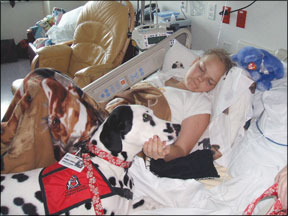A few months ago, I wrote about the British Kennel Club’s registration of two special Dalmatians over the objections of the breed clubs there (WDJ June 2010). These two dogs were the result of a breeding project begun in 1973, in which a single outcross to a Pointer was made in order to reintroduce the normal gene for uric acid back into the Dalmatian bloodline.

288
Fourteen generations later, more than 99.98 percent of the offspring’s genes are identical to those of a purebred Dalmatian. The one critical exception is that, unlike every other dog registered by both the British and American Kennel Clubs, these dogs are no longer at risk of forming urate bladder stones, a painful and potentially deadly condition caused by a genetic mutation carried by all Dalmatians.
Since that article was written, there have been some new developments. First, an update on what has been happening in Britain: Fiona (Fiacre First and Foremost), the first low uric acid (LUA) Dalmatian registered with the Kennel Club, has been winning at shows. While naysayers claimed her first win was “fixed,” Fiona’s group win the following week proved that these dogs are indistinguishable from other Dalmatians, and worthy of inclusion in breeding programs.
Meanwhile, back here in the States, theAmerican Kennel Club (AKC) Health & Welfare Advisory Committee submitted a report with the following recommendation:
“Because the introduction of the low uric acid dogs into the AKC registry gives Dalmatian breeders a scientifically sound method of voluntarily reducing the incidence of the condition, this committee strongly recommends some controlled program of acceptance of these dogs. Where the strict health and welfare of the breed is the over-riding concern, no other argument can be made.”
Despite these findings from its own committee, the AKC board voted in November to defer a decision until after June 2011, when a vote of the Dalmatian Club of America’s membership would be held. Since the breed clubs in both Britain and the U.S. have remained staunchly opposed to registration of LUA dogs, it seems unlikely that this vote will show them putting the welfare of their breed above their concerns of genetic purity. While AKC says it will “consider this vote, along with other factors in reaching its final decision,” don’t hold your breath in hopes that they will do the right thing.
In the meantime, another dog has paid the ultimate price for the breeders’ shortsightedness. Armstrong, a seven-year-old Dalmatian who worked as a therapy dog at the children’s cancer unit at the Primary Children’s Medical Center in Salt Lake City, Utah, was put to sleep due to uncontrollable urate stones.
Armstrong had previously undergone multiple surgeries to remove stones, followed by a urethrostomy, where the dog’s urethra is rerouted away from the penis to a new, surgically created opening. Even after such a drastic measure, Armstrong continued to form stones, requiring two more surgeries just five months apart.
His owner, Shelley Gallagher of Sandy, Utah, had been feeding Armstrong a low-purine diet, giving him extra fluids to help dilute his urine, letting him out to urinate every few hours (including every night at 2 am), and obsessively monitoring him – all, ultimately, to no avail.
If you’d like to let the Dalmatian Club of America know how you feel about this, email its president, Meg Hennessey, at president@thedca.org. For those interested in LUA Dalmatians, they are currently registered in the U.S. only with the United Kennel Club (UKC). – Mary Straus






